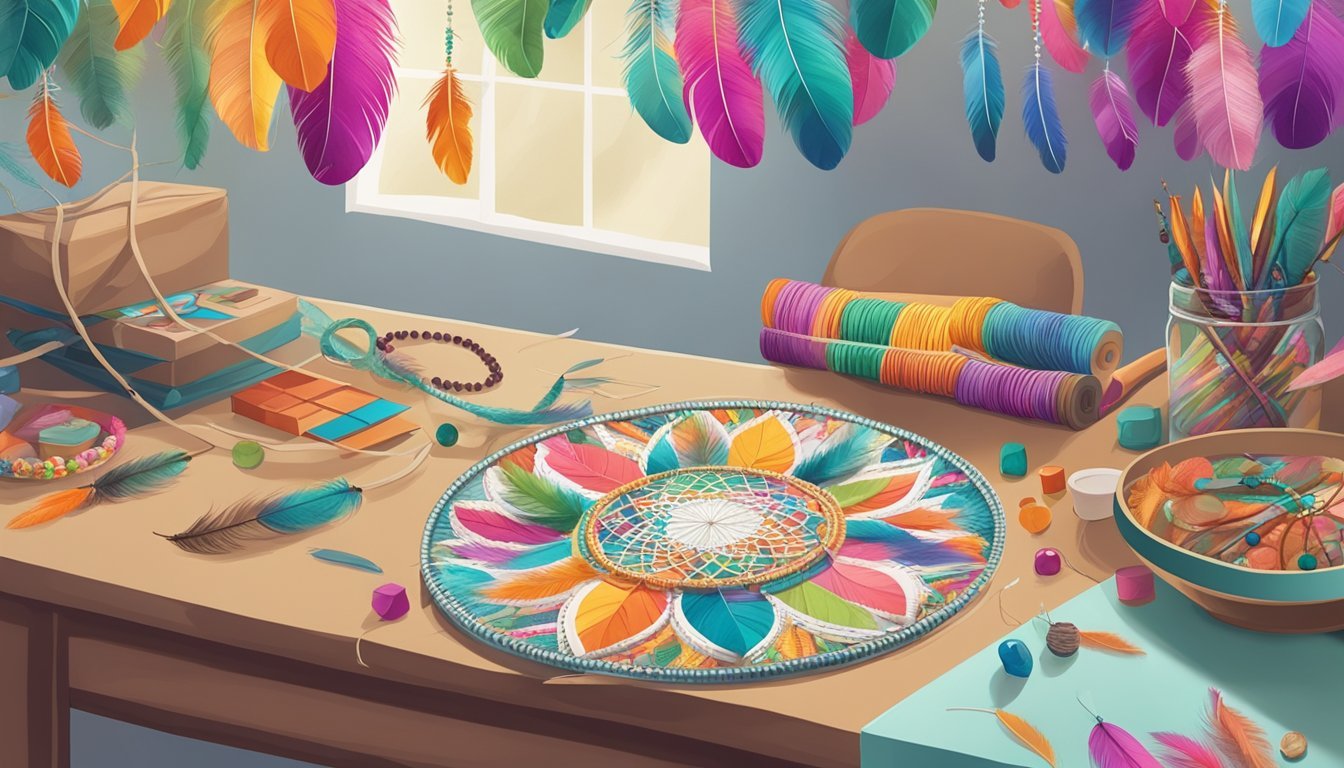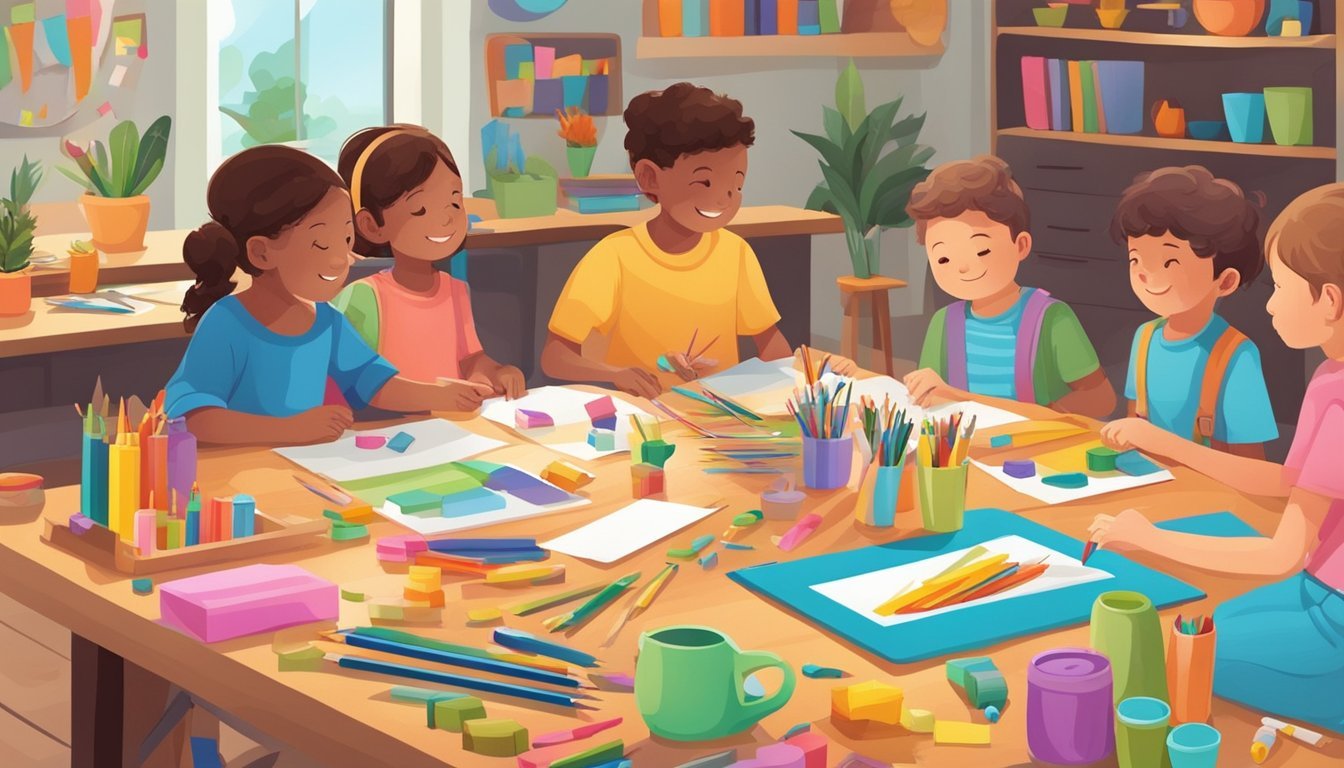Crafting with your kids can be a fun way to ignite their creativity and spend quality time together.
You can easily start a creative adventure with your children using simple craft supplies readily available at home.
Whether you’re looking to teach a new skill or just want to have some playful moments, the right crafts can provide both learning and laughter.

From recycled materials to colorful supplies, the possibilities are endless.
Getting your kids involved in crafting isn’t just about making art; it’s also a chance to bond and share ideas.
With a few basic items, you can transform ordinary moments into extraordinary memories.
1) Painted Rock Monsters
Painting rock monsters is a fun and creative project you can do with your kids.
Gather some large river rocks, which you can find at a craft store or on a nature walk.
For paints, use bright colors, preferably acrylic, as they are durable and can withstand the outdoors.
If you use other types of paint, consider applying a clear varnish to protect the design.
You’ll also need some basic supplies like paintbrushes, googly eyes, and markers for adding details.
Let your kids’ imaginations run wild as they create unique monsters with different expressions.
After painting, you can decorate with pipe cleaners or additional craft items to give each rock character.
Once finished, place the painted rocks in your garden or around your home for a splash of creativity.
This project not only entertains but also encourages artistic expression.
Enjoy the process and share the fun together!
2) Pasta Jewelry Necklaces
Creating pasta jewelry necklaces is a fun and engaging project for you and your kids.
It’s a simple activity that allows for creativity and customization.
To start, gather some pasta, yarn, and any craft supplies you have on hand.
Macaroni and penne work great for beading.
You can even dye the pasta with food coloring for added flair.
Next, thread the pasta onto the yarn.
You can mix different shapes and colors to make unique designs.
Encourage your kids to get creative with patterns.
Once they finish, tie the ends of the yarn together to create a necklace.
This craft not only results in a wearable piece of art but also enhances fine motor skills.
Pasta jewelry can be perfect for themed parties or gifts.
Plus, it’s an easy cleanup—just gather up the leftovers when you’re done.
Enjoy making memories while crafting!
3) Toilet Paper Roll Binoculars
Creating binoculars from toilet paper rolls is a simple and fun project for you and your kids.
It’s a great way to recycle materials you already have at home.
Start by gathering two empty toilet paper rolls.
If you want, you can wrap them in colorful construction paper for a decorative touch.
Use glue to secure the paper around the rolls.
Next, align the rolls side by side and glue them together.
This creates the basic structure of your binoculars.
For added fun, you can decorate the outside with stickers, markers, or drawings.
If you want to make the binoculars look more realistic, consider adding foam strips around the edges.
These strips can be glued on to enhance the grip.
Once everything is dry, your kids can take their new binoculars outside.
They can use them for pretend play, spotting birds, or going on treasure hunts.
This is a great way for them to be creative and engage with the world around them.
DIY Sock Puppets
Making sock puppets is a fun and creative way to spend time with your kids.
You only need some old socks and craft supplies like felt, buttons, and glue.
Start by picking a sock.
It can be any color or pattern.
Once you have your sock, turn it inside out and push your hand inside.
This will form the puppet’s mouth.
Next, get creative with the face.
Use buttons for eyes and felt scraps to make a nose and mouth.
You can even create fun animal shapes like a horse or dragon!
To add a bit of stability, consider gluing a piece of cardboard inside the sock where the mouth is.
This helps it hold its shape better.
Your kids can personalize their puppets with different colors and accessories.
Let them use their imagination to come up with unique designs.
Once the puppets are ready, put on a little show.
You can create stories together, making it a great bonding experience.
Making sock puppets is all about having fun and exploring creativity with your kids!
5) Paper Plate Dream Catchers

Making paper plate dream catchers is a fun and easy project for you and your kids.
You only need a few basic supplies like paper plates, scissors, and paints.
Start by cutting out the inner circle of the paper plate to create the frame.
This step is great for developing cutting skills in younger children.
Once you have your frame, let your kids paint both sides in vibrant colors.
Allowing them to choose their colors can spark creativity.
Next, use a hole punch to make holes around the inner edge.
This is where your kids can weave string, yarn, or other materials to create a web effect.
It’s a fantastic way to enhance fine motor skills and imaginative play.
You can also add feathers, beads, or any embellishments you have at home.
This personalized touch makes each dream catcher unique and special.
Hang your completed projects in their rooms or a common area.
They’ll love seeing their creations brighten up the space!
Safety Tips for Crafting with Kids

Crafting with kids can be a joyful experience, but safety should always come first.
Keeping your little ones safe while they explore their creativity is essential.
Here are some key considerations.
Choosing Age-Appropriate Materials
Select materials that are suitable for your child’s age.
Check labels for safety certifications like AP (Approved Product) or non-toxic indications.
Recommended Materials:
- Young Children (under 3): Use soft foam shapes, thick crayons, and washable paints.
- Preschool Kids (3-5): Consider glue sticks, safety scissors, and paper with rounded edges.
- Older Kids (6+): Introduce a wider range of materials like acrylic paints and sharp tools, but supervise closely.
Always discuss how to use specific materials safely.
For example, explain the importance of not putting small items in their mouths.
Keeping scissors and other sharp tools out of reach until needed is a good rule of thumb.
Setting Up a Safe Crafting Space
Create a designated crafting area that promotes safety and organization.
- Location: Choose a well-lit and spacious area where spills won’t cause issues.
- Workspace Cleanliness: Keep the workspace free from clutter. Regularly clear away scraps to minimize hazards.
Safety Equipment:
- First-Aid Kit: Have an up-to-date kit accessible in case of minor cuts or accidents.
- Protective Gear: Consider using safety goggles and aprons to protect clothing and eyes, especially during messy projects.
Make it a habit to wash hands after crafts.
This keeps germs in check and removes any potentially harmful materials from little fingers.
Encouraging Creativity and Imagination

Fostering creativity in your kids often means allowing them to express themselves freely.
Two effective ways to support this are by letting them take the lead in projects and incorporating storytelling into your activities.
Letting Kids Lead the Project
When kids have the chance to lead the crafting project, they become more invested and excited.
Start by gathering materials like paper, glue, markers, and whatever else you have around the house.
Encourage your child to decide what they want to create.
This can be anything from a collage to a homemade toy.
Let their imagination guide the process.
Ask questions like, “What do you want to make?” or “How do you want to decorate it?” This promotes decision-making skills and boosts their confidence.
Don’t be afraid to step back.
Offer help when needed, but let them explore their ideas without stepping in too much.
Celebrate their choices, even if the end product looks different from what you envisioned.
Incorporating Storytelling
Storytelling adds a whole new level of engagement to craft projects.
Transform the activity by having your child create characters or a setting that connects with a story.
You can start by discussing their favorite stories or making up new ones together.
Then, use craft supplies to bring those stories to life.
Encourage them to create a story box with small items representing different elements of the tale.
This could include figurines, drawings, or even scenes made from cardboard.
As they craft, prompt them to narrate their story.
This approach strengthens their narrative skills and allows them to express their thoughts creatively.
By merging art and storytelling, you enhance their imaginative play, making the entire experience both fun and educational.


